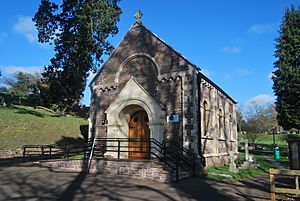Monmouth Cemetery facts for kids

The former chapel of rest in the Cemetery, built in 1851
|
|
| Details | |
|---|---|
| Established | 1 December 1851 |
| Location |
Osbaston Road, Monmouth
|
| Country | Wales |
| Owned by | Monmouthshire Council |
| Size | 7 acres (2.8 ha) |
Monmouth Cemetery is a special burial ground found on Osbaston Road in Monmouth, Wales. People were buried here from 1852 until 2012.
Contents
History of Monmouth Cemetery
Why the Cemetery Was Opened
Monmouth Cemetery first opened on December 1, 1851. It was officially blessed on June 23, 1852, by the Bishop of Llandaff. The very first burial happened just two days later, on June 25, 1852.
The cemetery was created because Monmouth's local council decided to close St Mary's Churchyard. There wasn't enough space for new burials there. This led to problems for people living nearby.
Growing the Cemetery Grounds
Henry Somerset, 7th Duke of Beaufort sold the land for the new cemetery to the council. Over time, the cemetery has grown much larger. Today, it covers about 7 acres (2.8 ha), which is roughly the size of seven football fields.
Nearby, the Monmouth Workhouse opened in 1870. This was a place where very poor people lived and worked. Also, Haberdashers' Monmouth School for Girls opened in 1897.
Special Burial Areas
Because the cemetery was close to the workhouse, a special area was set aside. This part was for people who were very poor and couldn't afford a proper burial. These "Paupers' Graves" usually didn't have names on them.
In 1909, a special wooden cross was placed there. It has a Latin message: Ave Crux Spes Unica. This means 'Hail, O Cross, Our Only Hope'. Today, Monmouthshire County Council looks after the cemetery.
The Cemetery Chapel
There is a small former chapel at the cemetery. It was designed by Rev. M. Wyatt and built in 1851. The chapel was closed to visitors around 1969.
However, it was fixed up and reopened in 2010. Now, it is used as a genealogy centre. This is a place where people can research their family history.
Visiting the Cemetery
The cemetery is always open to the public. You can park your car in a few spots. Because it's on a hillside, some of the paths are quite steep. In 2012, the cemetery stopped new burials because it had run out of space.
Cemetery Facilities
- There are three water points located along the paths.
- Limited parking is available near the chapel, in the middle, and at the top.
Notable People Buried Here
Many interesting people are buried at Monmouth Cemetery. Here are a few:
- William Wilson Allen VC - He was a brave soldier who fought in the Battle of Rorke's Drift. He received the Victoria Cross (VC), which is the highest military award for bravery. He died in 1890.
- Mary Ellen Bagnall Oakeley - She was a local artist and someone who studied old things (an antiquarian).
- Dr. Alfred Edwin Monahan - He was the third bishop of Monmouth. A bishop is a high-ranking leader in some Christian churches. He passed away in 1945.
War Graves at Monmouth Cemetery
The Commonwealth War Graves Commission looks after the graves of soldiers. They maintain the graves of eight British service members from World War I. Seven of these soldiers were from the Royal Monmouthshire Royal Engineers. There are also six graves from World War II.
Gallery
-
Sloping land sold to the council. Foreground headstones are of soldiers of the Royal Monmouthshire Royal Engineers, from World War I
Images for kids












